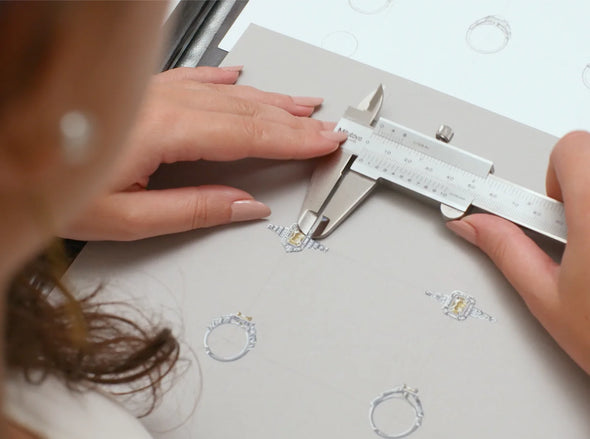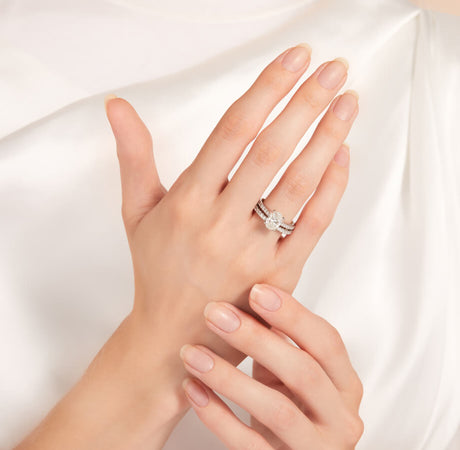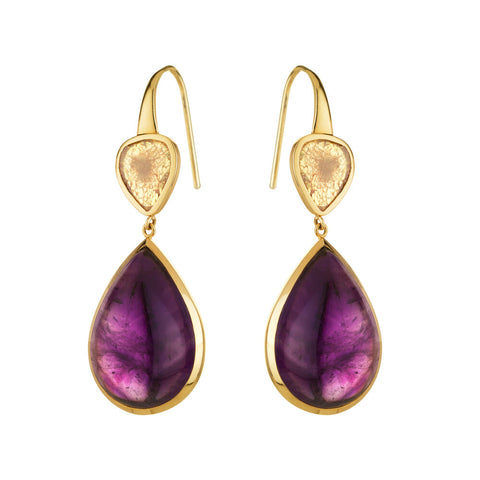From our GIA experts
Pear Cut Guide
For those moments that are as meaningful as they are memorable—like an engagement or proposal—choosing a symbol of love that reflects your unique story is everything. Pear cut diamonds, known for their graceful curves and distinctive silhouette, have long been admired for their romantic flair and versatility. We’ve created this guide to help you navigate the beauty and brilliance of pear-shaped diamonds as you take the next step in your journey together.
Pear 4cs
Choosing a Pear Diamond: Factors to Consider
When it comes to choosing a diamond that combines timeless beauty with a touch of individuality, the pear cut stands out effortlessly. Its unique teardrop shape elongates the finger and maximizes visual size, making it both flattering and eye-catching. This guide is designed to help you understand the key factors to consider when selecting a pear-shaped diamond, so your choice is as confident as it is captivating.
The Best Ratio for a Pear Cut Diamond
The length-to-width ratio plays a crucial role in the overall appearance of a pear cut diamond. This ratio affects how rounded or slender the stone looks—ranging from soft and classic to long and elegant. The ideal ratio for a pear diamond typically falls between 1.45 and 1.75, depending on personal style and how the diamond complements the wearer’s hand. A more elongated pear tends to lengthen the finger, while a shorter ratio offers a fuller, more traditional teardrop shape.
Pear Cut Guide
Cut quality is essential to a pear-shaped diamond’s brilliance. A well-cut pear should have a symmetrical outline, with a rounded end that’s not too wide or flat, and a pointed tip that aligns with the center. Watch for the bowtie effect, a dark shadow that can appear across the center—while a small bowtie is common, it should not detract from the stone’s sparkle or overall beauty.
Pear Colour Guide
Pear diamonds can show more visible color near the pointed tip, due to the way light travels through the elongated shape. For a bright, white look—especially in platinum or white gold—consider a color grade of H or higher. Warmer metals like yellow or rose gold can complement lower color grades like I or J beautifully without compromising overall appearance.
Pear Clarity Guide
Due to its open table and elongated shape, inclusions near the center or tip of a pear diamond can be more noticeable. Aim for a clarity grade of VS2 or higher, or ensure that any inclusions are well-placed and not visible to the naked eye. A clean, sharp point is also important for both beauty and durability.

How to choose a pear diamond
Buying Guide
The pear cut is a modified brilliant cut, meaning it shares the same facet structure as a round brilliant diamond but is reshaped into a teardrop silhouette—rounded on one end and pointed on the other. As part of the fancy cut family, the pear cut offers exceptional brilliance while presenting a distinctive, asymmetrical shape. It’s a striking blend of classic sparkle and graceful individuality, ideal for those who want something both elegant and unique.
-
Length-to-Width Ratio:
Pear cut diamonds generally have a length-to-width ratio between 1.45 and 1.75. A lower ratio creates a fuller, rounder shape, while a higher ratio results in a longer, more tapered silhouette. The ideal proportion depends on your personal style and how the diamond suits the wearer's hand.
Facets:
A classic pear cut diamond features 58 facets, designed in a brilliant style to maximize sparkle. These facets enhance both the rounded and pointed ends, giving the stone a lively and elegant brilliance.
Bowtie Effect:
Like many elongated cuts, pear diamonds may show a bowtie effect—a shadow across the center of the stone. While some bowtie is normal, a well-cut pear will minimize this and maintain consistent sparkle throughout the shape.
-
Length-to-Width Ratio:
When buying a pear cut diamond, consider the length-to-width ratio, as it strongly influences the diamond’s overall shape. A ratio around 1.50 to 1.60 is considered well-balanced, but some prefer a longer, more slender look or a shorter, rounder profile. Try viewing different ratios on the hand to see what feels most flattering.
Cut and Symmetry:
Cut quality is especially important in pear shapes. Look for a diamond with a well-proportioned outline—the rounded end should be smooth and symmetrical, and the point should align with the center. Poor symmetry can make the diamond appear off-balance or uneven when set.
Bowtie Visibility:
Most pear diamonds display some bowtie effect—a shadow that runs across the center. While it’s a natural part of the shape, you’ll want a stone where this effect is minimal and doesn't overpower the brilliance. Always view the diamond in motion to judge this properly.
The Tip:
The pointed tip of a pear diamond is the most vulnerable area. Choose a setting that offers adequate protection, such as a V-prong or bezel, to prevent chipping and ensure long-term durability.
-
Solitaire:
A single pear cut diamond on a simple band draws full attention to its unique teardrop shape. This classic setting emphasizes the stone’s elegance and works beautifully with both minimal and vintage-inspired styles.
Halo:
A halo of smaller diamonds surrounding the pear cut enhances its brilliance and adds visual size. This setting also softens the pointed tip and offers added sparkle, making the center stone appear even more radiant.
Three-Stone:
Flanking the pear diamond with side stones—like tapered baguettes or round brilliants—adds symmetry and a sense of balance. It’s a timeless choice that adds meaning and dimension to the design.
Bezel or V-Prong:
A bezel setting or a protective V-prong around the tip offers added durability without sacrificing style. These settings are ideal for everyday wear, especially for those who value both beauty and practicality.

Teardrop Tales
History of Pear Cut
The pear cut diamond, often referred to as the teardrop shape, blends the brilliance of a round cut with the graceful elongation of a marquise. Its origins trace back to the 15th century, when Flemish diamond cutter Lodewyk van Berquem developed the concept of the pear shape using his invention of the polishing wheel. This technique allowed for more precise facet placement and enhanced sparkle—revolutionary for its time. Over the centuries, the pear cut has remained a symbol of elegance and individuality, beloved for its romantic curves and flattering silhouette.
Ring Styles & Inspiration
Elizabeth Taylor famously wore the iconic Taylor–Burton Diamond, a breathtaking 69.42-carat pear-shaped diamond gifted by Richard Burton in 1969. Originally set in a ring, the stone was later transformed into a necklace due to its remarkable size. It remains one of the most legendary and extravagant pear-cut diamonds in history—a symbol of timeless glamour and passion.
Adele sparked engagement rumors when she was seen wearing an 8-carat pear-shaped diamond ring estimated to be worth over $800,000. With its classic silhouette and bold scale, the ring perfectly complements her understated, elegant style—bridging timeless sophistication with modern star power.


frequently asked questions
Unsure about anything? Find our frequently asked questions.
Can't find the answers your looking for? Our team is on hand from Monday to Friday, 10am - 5pm.
-
Yes—pear cut diamonds are a popular and elegant choice. Their distinctive teardrop shape combines the brilliance of a round cut with a flattering, elongated form that creates the illusion of longer fingers.
-
Like many elongated shapes, pear diamonds can show a bowtie effect—a faint shadow across the center. While it’s common, a well-cut stone will minimize this and maintain even sparkle throughout the diamond.
-
Traditionally, the pointed end faces outward toward the fingertip, but some prefer to wear it reversed for a unique look. There's no strict rule—it depends on what feels most flattering and personal to you.
-
Pear diamonds look stunning in solitaire, halo, and three-stone settings. Be sure the setting protects the pointed tip, often with a V-prong, to prevent chipping and ensure durability.

Bespoke Services
Design your own bespoke engagement rings and transform ideas into reality.
We specialise in made-to-order diamond engagement rings. Whether you recreate one of our classic designs or have an idea of your own.





